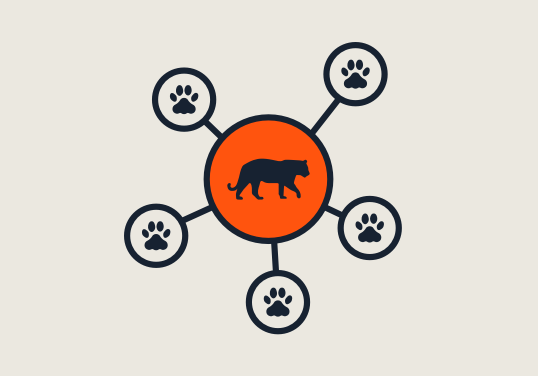About Tigers
Known worldwide for its distinctive stripes and imposing size, the tiger (Panthera tigris) is one of the most iconic wildlife species in existence. While tigers are ubiquitous in music, sports and on our screens, they are much rarer in the wild and hovering close to extinction with only 4,500 remaining. But tiger habitat remains, giving us hope for a dramatic recovery if we rally behind tigers and protect them from poachers.
Securing A Viable Future For Tigers
Read here to learn what six NGOs (including Panthera) which support the Global Tiger Initiative and Global Tiger Recovery Program suggest must be done to strengthen tiger conservation and protect these big cats across their range.
Tiger Dialogues
Tiger Dialogues series, hosted by WWF-India, WCS-India and Panthera, explores tiger conservation in a historical light. Throughout the series, new avenues will be explored, and interesting insights will be given into the past, present and future of tiger conservation. Read more and join the event.
Our Goals



Where Do Tigers Live?
Tigers live mainly in the forests of tropical Asia, though they also roam colder climates like those in the Russian Far East. They currently exist in 10 countries, including Thailand, Myanmar, Malaysia, Indonesia, Bhutan, Bangladesh, Nepal, India, China and Russia.
- Historic Tiger Range
- Current Tiger Range
Tiger FAQs
Why do tigers have stripes?
Tigers’ stripes allow them to blend into their environment and sneak up on prey. Since each stripe pattern is unique, we can use camera traps to figure out how many tigers make up a population and to track their specific movements and activities.
What do tigers eat and how do tigers hunt?
Tigers prefer wild pigs, deer and wild cattle (including gaur, which can weigh up to 3,300 lbs!) across their habitats. They also opportunistically hunt birds, fish, rodents, insects and reptiles in addition to other mammals like primates and porcupines. Tigers usually hunt during morning and evening when their prey are most active, stalking prey and then ambushing them with an explosive burst of energy.
Do tigers purr or roar?
Tigers cannot purr continually. Instead, they can roar thanks to unique modifications of the larynx and an elastic hyoid structure. Tigers are also known to chuff, which is a non-threatening vocalization they use to communicate between themselves.
How many cubs do tigers have? How long do cubs stay with their mother?
Tigers usually have litters of two to five cubs. After three to five months, the cubs are weaned off their mother’s milk. By 18 to 24 months they are fully independent. Males disperse widely and females tend to stay closer to their mother’s territory.
What threats do tigers face?
Poaching for the illegal wildlife trade and habitat loss have driven the great decline in tigers over the last century. Tigers are illegally killed for their body parts, which are usually sold for use in Traditional Chinese Medicine. Tigers are also threatened by overhunting of prey species and killings in retaliation to attacks on livestock or people.
What does Panthera do to protect tigers?
Panthera protects tigers by preventing poaching and disrupting the illegal wildlife trade, the cat’s greatest threats. In partnership with national governments and local communities, we train anti-poaching rangers to safely and effectively deter and respond to poaching incidents and give them the equipment they need to accomplish this dangerous job. We work with local judiciary members to increase prosecutions and penalties for members of the criminal syndicates who are devastating tiger habitats. By advocating for expanded or new protected areas, we are increasing the size and connectivity of key tiger habitats. We also support sustainable livelihoods for local communities to reduce their dependence on unsustainable resource extraction (like prey hunting and wood harvesting) from tiger habitats.




60c6.jpg?itok=dpqdldzS)